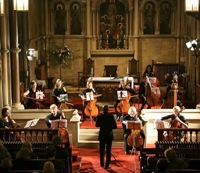Difference between revisions of "Ensemble"
m (Text replacement - "http://" to "https://") |
|||
| Line 3: | Line 3: | ||
==Etymology== | ==Etymology== | ||
French, from ensemble [[together]], from Old French, from [[Latin]] insimul at the same time, from in- + simul at the same time | French, from ensemble [[together]], from Old French, from [[Latin]] insimul at the same time, from in- + simul at the same time | ||
| − | *Date: [ | + | *Date: [https://www.wikipedia.org/wiki/18th_Century 1750] |
==Definitions== | ==Definitions== | ||
*a [[group]] producing a single [[effect]]: as a : concerted [[music]] of two or more parts | *a [[group]] producing a single [[effect]]: as a : concerted [[music]] of two or more parts | ||
| Line 13: | Line 13: | ||
A [[group]] of [[two]] musicians is called a ''duo'', a group of [[three]] is a ''trio'', a group of four a ''quartet'', and a group of five a ''quintet''. A musician who usually [[performs]] alone is usually termed a solo musician or solo artist. | A [[group]] of [[two]] musicians is called a ''duo'', a group of [[three]] is a ''trio'', a group of four a ''quartet'', and a group of five a ''quintet''. A musician who usually [[performs]] alone is usually termed a solo musician or solo artist. | ||
| − | In [ | + | In [https://en.wikipedia.org/wiki/Classical_music classical music], trios or quartets either blend the [[sounds]] of musical instrument families (such as [https://en.wikipedia.org/wiki/Piano piano], [https://en.wikipedia.org/wiki/Strings_(music) strings], and [https://en.wikipedia.org/wiki/Wind_instrument wind instruments]) or [[group]] [[together]] instruments from the same instrument family, such as string ensembles or wind ensembles. In jazz ensembles, the instruments typically include wind instruments (one or more saxophones, trumpets, etc.), one or two chordal "comping" instruments (electric guitar, piano, or organ), a bass instrument (electric bass guitar or double bass), and a drummer or percussionist. In rock ensembles, usually called [https://en.wikipedia.org/wiki/Rock_Music rock bands], there are usually guitars and keyboards (piano, electric piano, Hammond organ, synthesizer, etc.) and a [[rhythm]] section made up of a bass guitar and drum kit.[https://en.wikipedia.org/wiki/Musical_ensemble] |
[[Category: The Arts]] | [[Category: The Arts]] | ||
Latest revision as of 00:55, 13 December 2020
Etymology
French, from ensemble together, from Old French, from Latin insimul at the same time, from in- + simul at the same time
- Date: 1750
Definitions
- b : a complete costume of harmonizing or complementary clothing and accessories
- c (1) : the musicians engaged in the performance of a musical ensemble (2) : a group of supporting players, singers, or dancers; especially : corps de ballet
Description
A musical ensemble is a group of two or more musicians who perform instrumental or vocal music. In each musical style different norms have developed for the sizes and composition of different ensembles, and for the repertoire of songs or musical works that these ensembles perform.
A group of two musicians is called a duo, a group of three is a trio, a group of four a quartet, and a group of five a quintet. A musician who usually performs alone is usually termed a solo musician or solo artist.
In classical music, trios or quartets either blend the sounds of musical instrument families (such as piano, strings, and wind instruments) or group together instruments from the same instrument family, such as string ensembles or wind ensembles. In jazz ensembles, the instruments typically include wind instruments (one or more saxophones, trumpets, etc.), one or two chordal "comping" instruments (electric guitar, piano, or organ), a bass instrument (electric bass guitar or double bass), and a drummer or percussionist. In rock ensembles, usually called rock bands, there are usually guitars and keyboards (piano, electric piano, Hammond organ, synthesizer, etc.) and a rhythm section made up of a bass guitar and drum kit.[1]
